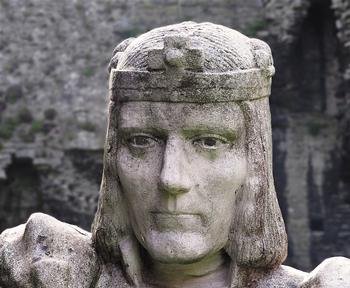Quiz Answer Key and Fun Facts
1. Many English monarchs have had nicknames. William I is known as William the Conqueror, John known as Lackland. Which of the following was Edward I NOT known as?
2. Who was Edward's first wife?
3. After being a widower for nine years, Edward remarried. Who was his second wife?
4. Edward I, like most medieval kings, had several mistresses and more than ten illegitimate children.
5. How many children did Edward have?
6. The Maundy ceremony, during which on Maundy Thursday money is distributed to the needy, was instituted by Edward I.
7. In an effort to reform the administration of justice, local dignitaries were appointed to assist. By what name were these officials known?
8. Where was Edward when he was advised that his father had died and he was King of England?
9. In the struggle betweem Simon de Montfort and King Henry III, what was Edward's position?
10. According to legend, after being subjugated by Edward I, the Welsh requested a prince who spoke neither English nor French; Edward presented his newborn son, Edward of Caernarvon. If this legend is correct, at the time of his presentation to the Welsh as their prince, Edward of Caernarvon was not the heir to the English throne since he was the younger surviving son of Edward I. Who was the heir?
11. William Wallace was one of the leaders of the Scots against Edward I. What became of Wallace?
12. The story of William Wallace was depicted in the Mel Gibson movie "Braveheart". In that movie, it suggested that Edward III was really the result of an sexual relationship between Edward I and his daughter-in-law Isabella of France. Is there any possibility of this being fact?
13. The cause of Edward's determination to conquer Wales, which resulted in the creation of his son as Prince of Wales, can be traced to the time of Edward I's coronation. When Wales's prince failed to attend to give fealty in Chester, Edward mounted a campaign against the Welsh. The result was the Treaty of Aberconwy in November 1277, which reduced the authority of the Welsh prince. Which prince led Wales at this time?
14. In 1278, Edward enacted a law, possibly at the instigation of his mother. What was the impact of that law?
15. Margaret, the Fair Maid of Norway, was the last direct descendant of Alexander III and was slated to marry Edward's heir. The death of the infant Margaret on her way from Norway to Scotland thwarted that plan and left Scotland with no direct heir. As a result, Edward was asked to choose between competing claims to the throne. How many claimants were there to the Scottish throne initially?
16. In order to pacify Wales, Edward embarked upon a programme of building castles and other strongholds, which cost upwards of 80,000 pounds and employed a work force of 3500 persons.
17. Philip IV undertook a programme of harassment of Edward in his remaining French fief of Gascony. In 1295 Edward planned a campaign in order to regain Gascony, which had been confiscated by Philip. In order to raise money, what notable event occurred in England?
18. What was the purpose of the "Hundred Rolls"?
19. Edward used Parliament to an extent heretofore unknown. What were the significant legislative statute(s) of his reign?
20. What was Edward's final request?
Source: Author
tripeuro
This quiz was reviewed by FunTrivia editor
fringe before going online.
Any errors found in FunTrivia content are routinely corrected through our feedback system.

